What is the Radiofrequency-Based Aesthetic Devices Market Size?
The global radiofrequency-based aesthetic devices market size was calculated at USD 1.47 billion in 2024 and is predicted to increase from USD 1.63 billion in 2025 to approximately USD 4.01 billion by 2034, expanding at a CAGR of 10.56% from 2025 to 2034. The growth of the market is driven by rising demand for non-invasive cosmetic procedures, increasing awareness of skin rejuvenation, and advancements in RF technology.
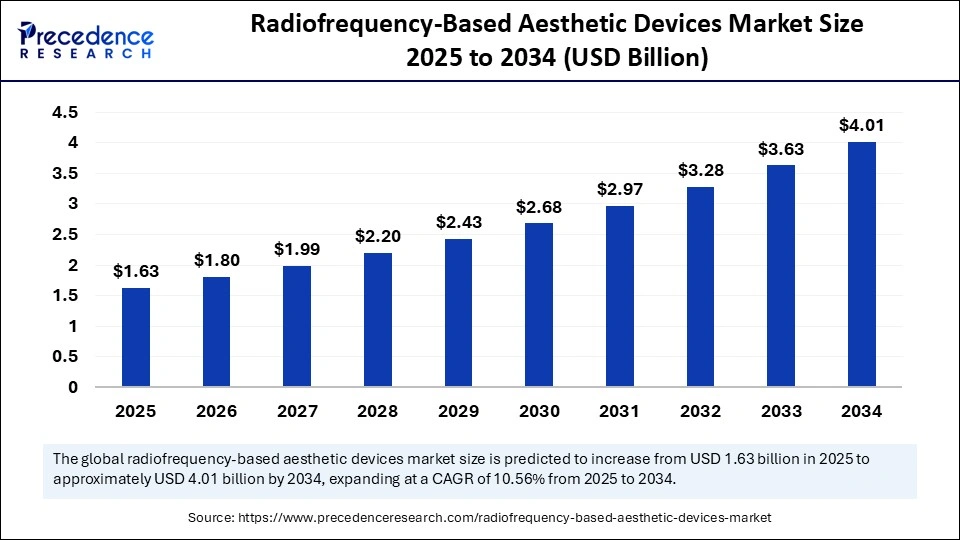
Market Highlights
- North America dominated the radiofrequency-based aesthetic devices market with a 42% share in 2024.
- The Asia Pacific region is expected to grow at the fastest CAGR between 2025 and 2034.
- By product type, the platform systems / consoles segment held a 72% share of the market in 2024.
- By product type, the accessories, software & service contracts segment is expected to grow at the highest CAGR during the forecast period.
- By RF technology/modality, the multipolar RF segment dominated the market with a 40% share in 2024.
- By RF technology/modality, the fractional microneedle RF is expected to grow at the fastest rate in the upcoming period.
- By application/indication, the skin tightening & wrinkle reduction segment held a 38% share of the market in 2024.
- By application/indication, the body contouring / circumferential reduction segment is expected to expand at the highest CAGR in the coming years.
- By end user/channel, the medical aesthetic / dermatology clinics segment dominated the market while holding a 55% share in 2024.
- By end user/channel, the medspas & cosmetic chains segment is likely to grow at a rapid pace over the forecast period.
- By usage pattern/consumable model, the reusable handpieces with scheduled servicing segment held a 70% share of the market in 2024.
- By usage pattern/consumable model, the disposable tips/cartridges segment is expected to grow at the fastest CAGR between 2025 and 2034.
- By deployment mode, the in-office professional use segment led the market while capturing a 85% share of the market in 2024,
- By deployment mode, the home-use / at-home rf devices segment is likely to grow at a significant CAGR over the projection period.
Market Size and Forecast
- Market Size in 2024: USD 1.47 Billion
- Market Size in 2025: USD 1.63 Billion
- Forecasted Market Size by 2034: USD 4.01 Billion
- CAGR (2025-2034): 10.56%
- Largest Market in 2024: North America
- Fastest Growing Market: Asia Pacific
What is Radiofrequency-Based Aesthetic Devices Market?
The radiofrequency (RF) aesthetic devices market covers in-office and at-home systems that use RF energy (monopolar, bipolar, multipolar, fractionated, microneedle RF, and hybrid RF+energy combinations) to produce thermal effects in skin and subcutaneous tissue for skin tightening, wrinkle reduction, body contouring, cellulite reduction, scar remodeling, and collagen induction. RF devices are used in dermatology and medical aesthetic clinics, medspas, and increasingly in ambulatory surgery centers. The market's revenue pool is driven by capital device sales (OEM systems), recurring consumables/accessories, procedure volumes, and software/maintenance contracts; growth is supported by rising demand for minimally invasive procedures, combination therapies, and adoption in emerging markets.
Impact of AI on the Radiofrequency-Based Aesthetic Devices Market
Artificial intelligence (AI) is significantly transforming the radiofrequency-based aesthetic devices market by enhancing treatment precision, personalization, and overall efficacy. AI algorithms are being integrated into RF systems to analyze skin types, monitor treatment parameters in real time, and automatically adjust energy levels for optimal results, reducing the risk of burns or ineffective treatments. This improves both safety and patient satisfaction, leading to greater trust and wider adoption. Moreover, AI-powered data analytics helps practitioners track patient progress and outcomes, streamlining clinical workflows. As demand for personalized and results-driven aesthetic treatments grows, AI integration is becoming a key differentiator in next-generation RF devices.
What are the Major Trends in the Radiofrequency-Based Aesthetic Devices Market?
- AI Integration for Personalized Treatments: AI is being incorporated into RF devices to offer personalized energy delivery based on skin type, treatment area, and patient feedback. This enhances safety, treatment outcomes, and overall user experience, especially in professional settings.
- Rising Adoption in Medspas and Cosmetic Chains: Medspas and aesthetic chains are rapidly expanding, especially in urban and emerging markets, offering RF-based treatments at accessible price points. Their growing popularity is widening the consumer base beyond traditional dermatology clinics.
- Growth of At-Home RF Devices: Consumer interest in self-care and convenience is driving the growth of compact, user-friendly RF devices for home use. These devices appeal to busy users seeking regular maintenance treatments without clinical visits.
Market Scope
| Report Coverage | Details |
| Market Size in 2024 | USD 1.47 Billion |
| Market Size in 2025 | USD 1.63 Billion |
| Market Size by 2034 | USD 4.01 Billion |
| Market Growth Rate from 2025 to 2034 | CAGR of 10.56% |
| Dominating Region in 2024 | North America |
| Fastest Growing Region | Asia Pacific |
| Base Year | 2024 |
| Forecast Period | 2025 to 2034 |
| Segments Covered | Product Type, RF Technology / Modality, Application / Indication, End User / Channel, Usage Pattern / Consumable Model, Deployment Mode, and Region |
| Regions Covered | North America, Europe, Asia-Pacific, Latin America, and Middle East & Africa |
Market Dynamics
Drivers
Growing Demand for Non-Invasive Aesthetic Procedures
The global preference for non-invasive cosmetic treatments has surged due to their minimal downtime, lower risks, and natural-looking results. Radiofrequency (RF)-based devices align perfectly with this trend, offering effective solutions for skin tightening, wrinkle reduction, and body contouring without surgery. This has led to widespread adoption in dermatology clinics, medspas, and even home settings. The growing awareness of aging-related skin concerns among millennials and Gen Z is also fueling the demand. As a result, RF-based aesthetic procedures are becoming a mainstream option in beauty and wellness routines.
Restraint
High Cost of Advanced RF Systems
Despite growing popularity, the high initial investment and maintenance costs of advanced RF aesthetic systems remain a barrier, particularly for small clinics and individual practitioners. Premium devices with features like multi-modality integration or AI assistance can be prohibitively expensive, limiting access in cost-sensitive markets. Additionally, the need for trained professionals to operate these systems adds to operational costs. For end users, treatment prices also remain relatively high, which can deter repeat procedures. This cost barrier may slow down adoption in regions with limited healthcare infrastructure or low disposable income.
Opportunity
Technological Advancements in RF Devices
Continuous innovation in RF technology, such as fractional microneedle RF, temperature-controlled systems, and multipolar RF modalities, is enhancing treatment outcomes and patient comfort. These advanced systems allow practitioners to precisely target deeper skin layers, promoting collagen production and skin rejuvenation with minimal side effects. Moreover, smart features like real-time feedback and AI-based customization are improving safety and clinical efficiency. Such innovations not only attract medical professionals but also boost consumer confidence in RF treatments. This technological evolution is a strong driver for market expansion across both developed and emerging regions.
Segment Insights
Product Type Insights
Why Did the Platform Systems / Consoles Segment Dominate the Market in 2024?
The platform systems / consoles segment dominated the radiofrequency-based aesthetic devices market with a 72% share in 2024 due to their multifunctionality, offering various RF modalities and treatment options within a single device. These systems are preferred by medical professionals and clinics for their versatility and ability to deliver high-quality results across multiple applications such as skin tightening and body contouring. The high initial investment in these consoles is justified by their durability and wide treatment capabilities. Their dominance is also driven by the demand for comprehensive solutions in professional settings.
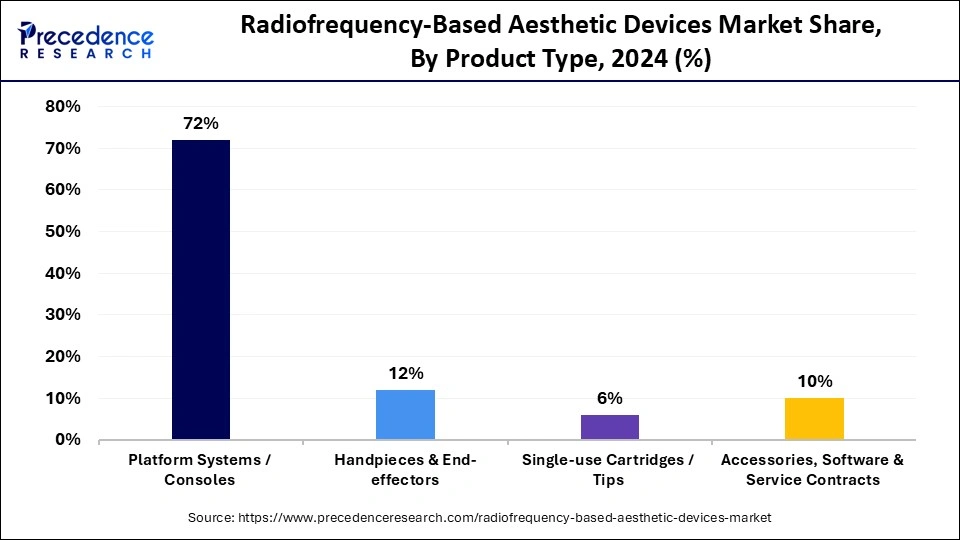
The accessories, software, and service contracts segment is expected to grow at the highest CAGR as clinics and providers increasingly rely on enhanced software for better treatment precision and patient management. Additionally, ongoing maintenance contracts and consumables are essential for the continuous operation of RF devices, driving recurring revenue streams. The rise of data-driven treatments and integration with AI-based monitoring tools also boosts demand. Growth is further supported by the increasing replacement and upgrading cycles in established clinics.
RF Technology / Modality Insights
What Made Multipolar RF the Dominant Segment in the Market?
The multipolar RF technology segment dominated the radiofrequency-based aesthetic devices market in 2024 with a 40% share, favored for its ability to deliver uniform energy distribution with reduced pain and downtime. Its efficiency in treating various skin types and its safety profile make it a preferred choice among practitioners and patients. Multipolar RF is highly effective for skin tightening and wrinkle reduction, contributing to its widespread adoption. The technology's non-invasive nature and proven clinical outcomes continue to sustain its market leadership.
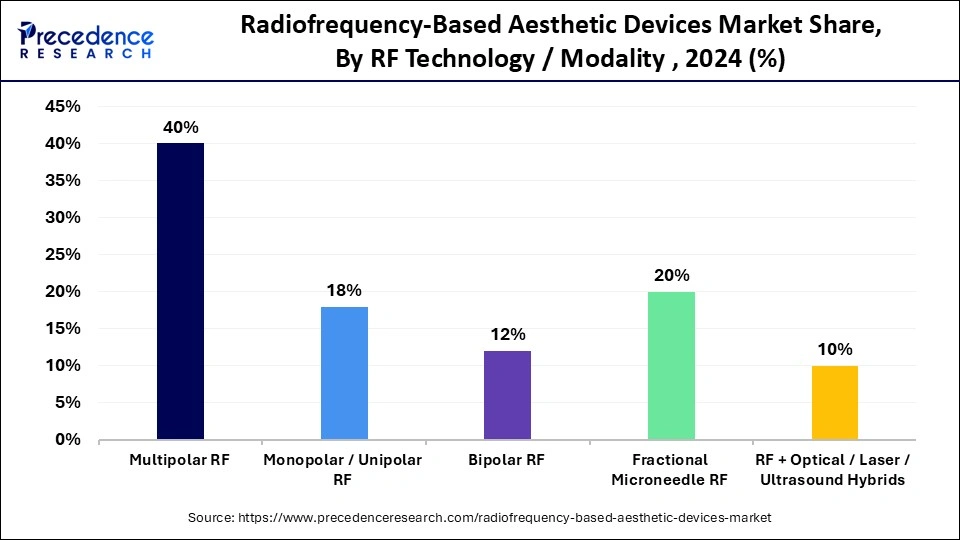
Fractional microneedle RF is anticipated to grow at the fastest rate in the upcoming period due to its minimally invasive approach that combines RF energy with micro-needling to stimulate collagen production effectively. This technology is gaining popularity for treating scars, wrinkles, and skin texture issues with minimal side effects. Its targeted delivery method appeals to patients seeking precise and effective results with shorter recovery times. Increasing clinical endorsements and expanding applications in dermatology boost its growth trajectory.
Application / Indication Insights
How Does the Skin Tightening & Wrinkle Reduction Segment Lead the Market?
The skin tightening & wrinkle reduction segment led the radiofrequency-based aesthetic devices market by holding a 38% share in 2024, driven by high demand from aging populations and individuals seeking non-surgical facial rejuvenation. Radiofrequency treatments offer a safe, effective alternative to invasive procedures, appealing to consumers wary of surgery. Growing awareness of aesthetic options and advancements in RF technology that improve efficacy and comfort have supported this segment. The rising prevalence of skin laxity and demand for youthful appearance continue to drive adoption.
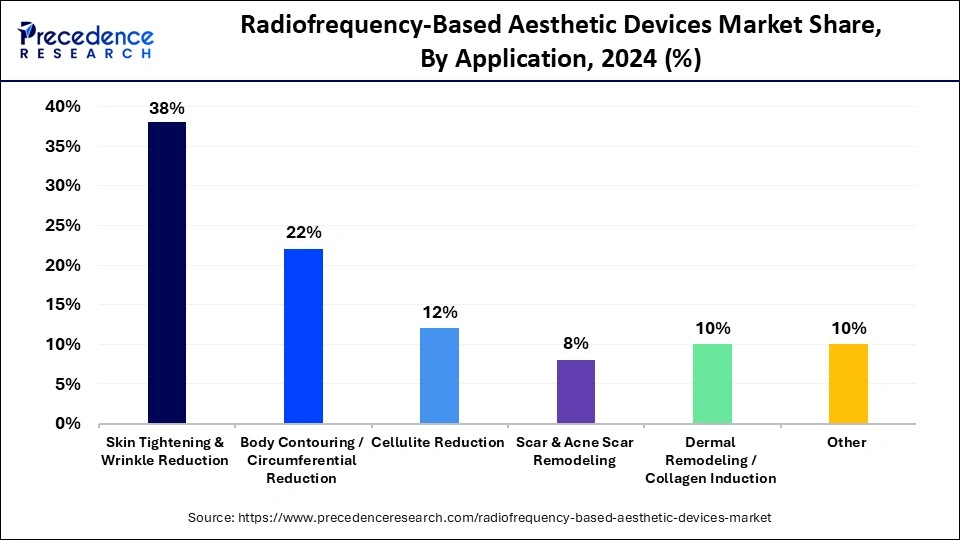
The body contouring / circumferential reduction segment is expected to expand at the highest CAGR over the projection period as concerns over obesity and body aesthetics rise globally. RF devices provide non-invasive fat reduction and skin tightening, making them attractive to patients avoiding surgery or downtime. Increasing use in medical spas and dermatology clinics, along with advancements in multi-modality devices that enhance results, fuel this segment's growth. Enhanced patient satisfaction and increasing marketing of body contouring treatments contribute to its rapid rise.
End User / Channel Insights
Why Did Medical Aesthetic / Dermatology Clinics Hold the Largest Market Share in 2024?
Medical aesthetic & dermatology clinics dominated the radiofrequency-based aesthetic devices market with a 55% market share in 2024, driven by their capability to provide professional, specialized RF treatments with high safety and efficacy standards. These clinics have skilled practitioners and invest in advanced RF devices, making them the preferred choice for consumers seeking reliable cosmetic procedures. The demand for personalized care and the ability to offer multiple treatment options under one roof support this dominance. Clinics also benefit from repeat visits for maintenance treatments, strengthening their market hold.
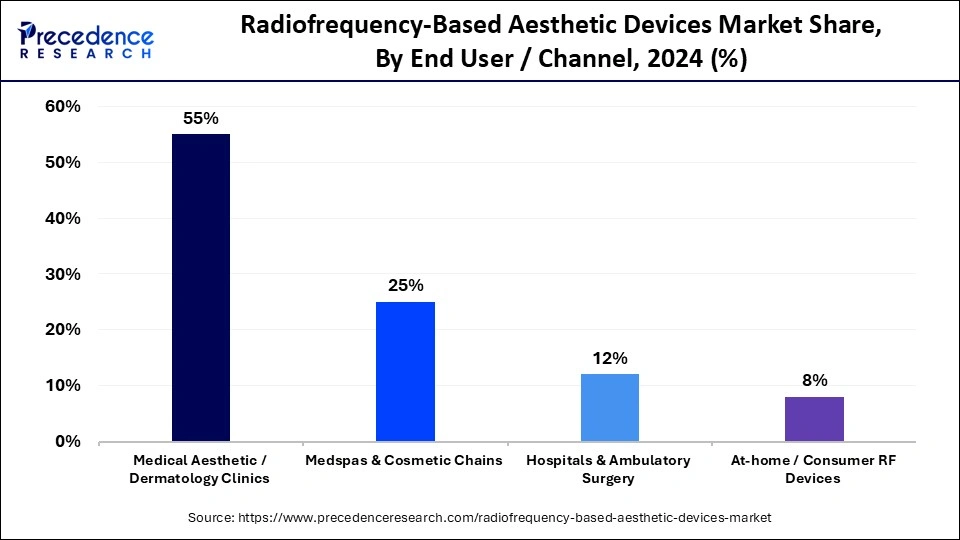
The medspas & cosmetic chains segment is expected to grow rapidly during the forecast period due to their growing popularity as affordable, convenient venues for non-invasive aesthetic treatments. These establishments attract younger demographics and first-time users with competitive pricing and promotional packages. The expansion of medspas in urban and suburban areas and the increasing trend of self-care and wellness boost market penetration. Their focus on customer experience and rapid service delivery accelerates demand growth in this segment.
Usage Pattern / Consumable Model Insights
Why Did the Reusable Handpieces with Scheduled Servicing Segment Dominated the Market?
The reusable handpieces with scheduled servicing segment held a dominant 70% share of the radiofrequency-based aesthetic devices market in 2024 because they offer cost-effectiveness and long-term reliability for clinics and providers. Regular servicing ensures consistent performance and patient safety, which is critical in medical settings. These handpieces support a wide range of treatments and are preferred for their durability and lower per-treatment cost compared to disposables. Their established use in professional environments contributes to their market leadership.
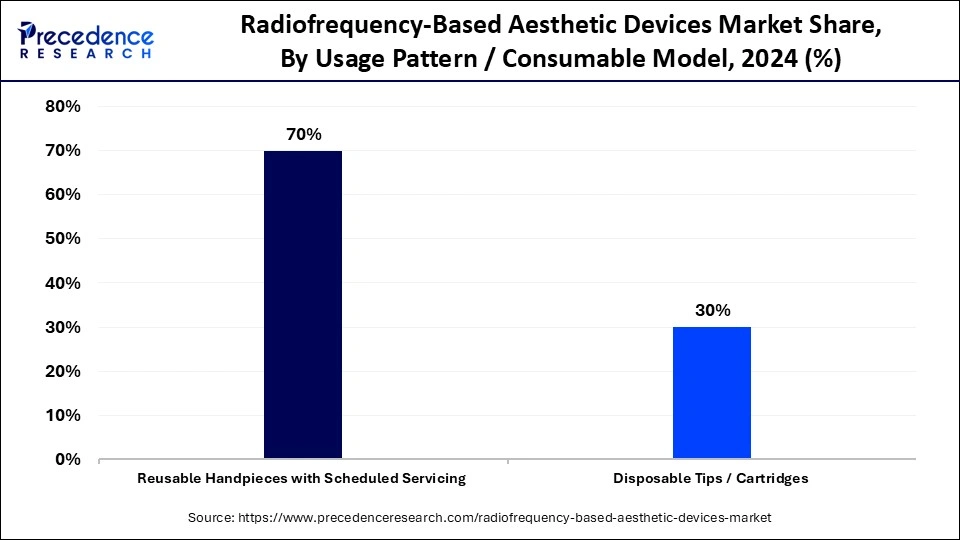
The disposable tips / cartridges segment is projected to grow at the fastest CAGR as they minimize cross-contamination risks and reduce downtime associated with cleaning and maintenance. Growing concerns over hygiene and infection control, especially post-pandemic, drive demand in clinics and medspas. Disposable consumables also allow for precise, tailored treatments and simplify device handling. This segment benefits from the increasing adoption of RF devices in settings with high patient turnover.
Deployment Mode Insights
How Does the In-Office Professional Use Segment Registered Dominance in the Market?
The in-office professional use segment registered dominance in the radiofrequency-based aesthetic devices market with an 85% share in 2024 as most RF treatments require skilled professionals and specialized equipment available in clinical settings. Patients prefer undergoing treatments under medical supervision to ensure safety and optimal results. Clinics and dermatology centers invest heavily in advanced RF platforms, reinforcing their dominant share. The complexity of procedures and the need for tailored treatment plans support continued in-office preference.
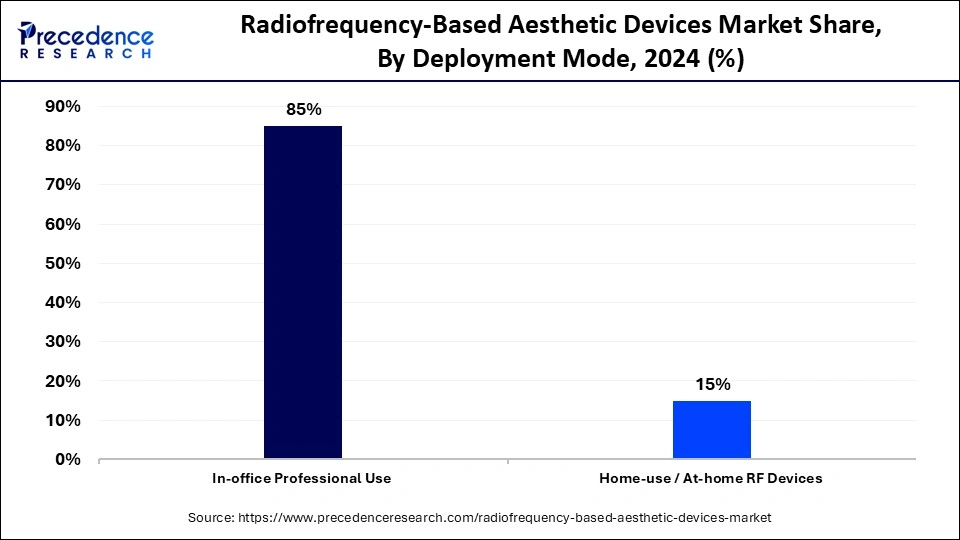
The home-use / at-home RF devices segment is expected to grow significantly during the projection period as consumer demand rises for convenient, affordable, and non-invasive skincare solutions. Advances in device miniaturization and user-friendly designs have made at-home RF treatments more accessible. Increasing consumer awareness of self-care and preventive skincare, coupled with growing e-commerce channels, fuels this segment's expansion. While professional use dominates, the convenience of at-home options is driving notable market growth.
Regional Insights
U.S. Radiofrequency-Based Aesthetic Devices Market Size and Growth 2025 to 2034
The U.S. radiofrequency-based aesthetic devices market size was evaluated at USD 432.18 million in 2024 and is projected to be worth around USD 1,201.50 million by 2034, growing at a CAGR of 10.77% from 2025 to 2034.
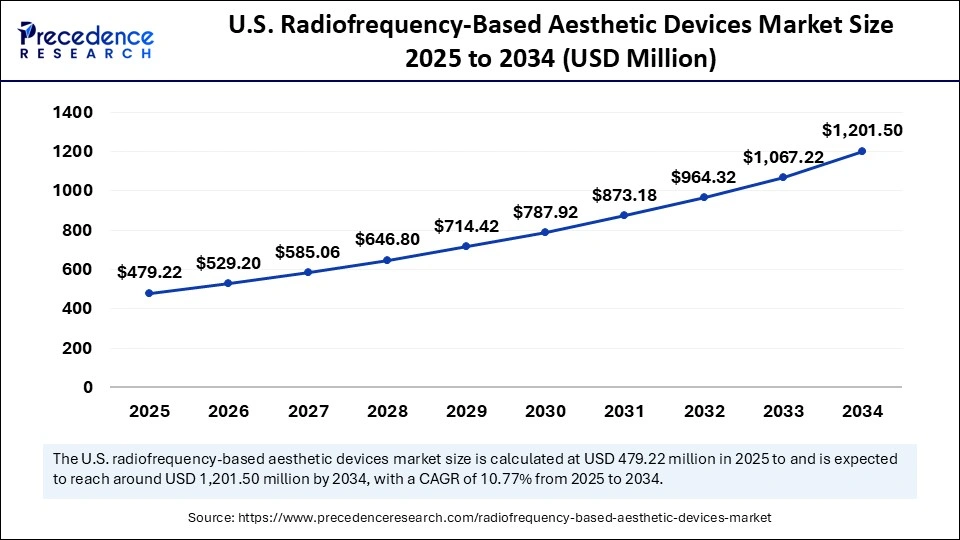
What Made North America the Dominant Region in the Market?
North America dominated the radiofrequency-based aesthetic devices market, holding a 42% share in 2024.This is primarily due to high healthcare expenditure, well-established medical aesthetic infrastructure, and strong consumer awareness of advanced cosmetic procedures. The presence of key market players and favorable reimbursement policies further supported market growth. Additionally, growing demand for minimally invasive treatments in both urban and suburban populations contributed to this dominance. The region's advanced regulatory framework and innovation-friendly environment also boosted adoption rates.
The U.S. is the major contributor to the North America radiofrequency-based aesthetic devices market. This is due to its advanced healthcare infrastructure, high consumer demand for non-invasive cosmetic procedures, and the presence of leading medical aesthetic companies headquartered in the country. Additionally, increasing awareness about skincare and anti-aging treatments, coupled with favorable reimbursement policies and robust R\&D activities, further drive market growth in the U.S. The country's well-established network of dermatology clinics and medspas also supports strong adoption of RF-based aesthetic devices.
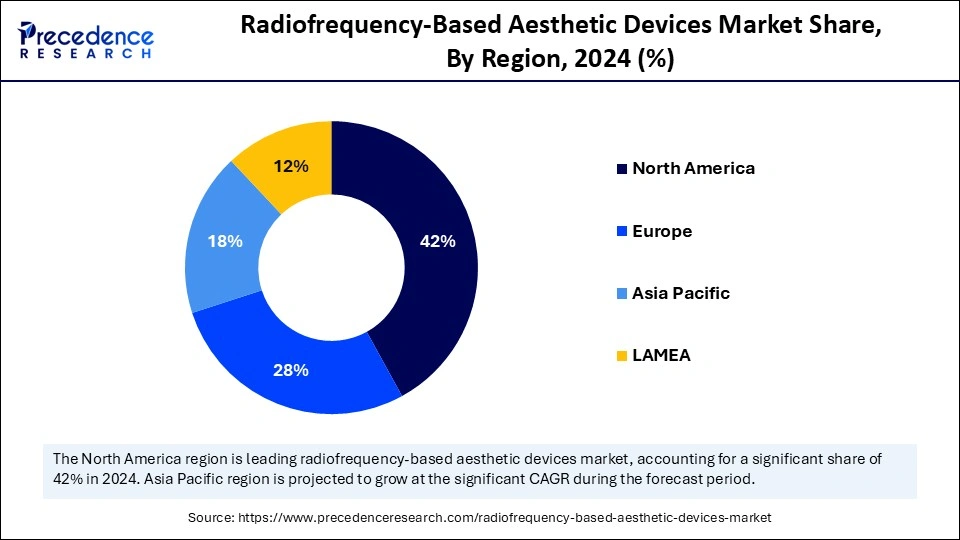
What Makes Asia Pacific the Fastest-Growing Region?
Asia Pacific is expected to register the fastest CAGR between 2025 and 2034, driven by rising disposable incomes, increasing beauty consciousness, and expanding medical tourism. Rapid urbanization and a growing middle-class population in countries like China, India, and South Korea fuel demand for aesthetic procedures. Moreover, increasing investments by manufacturers to expand their footprint and the introduction of affordable devices further stimulate market growth. The expanding healthcare infrastructure and rising awareness of non-invasive cosmetic treatments also drive market growth.
China is the major contributor to the Asia Pacific radiofrequency-based aesthetic devices market. This is due to the country's large and growing middle-class population with rising disposable incomes and increasing awareness of aesthetic treatments. Rapid urbanization and a strong focus on beauty and personal care also fuel demand for non-invasive procedures like RF-based devices. Additionally, expanding medical infrastructure and the presence of numerous clinics and medspas across major cities support market growth. Government initiatives promoting healthcare modernization further accelerate adoption in China.
Radiofrequency-Based Aesthetic Devices Market Companies
- InMode (platforms + RF microneedling devices)
- Cutera
- Alma Lasers
- Lutronic
- Cynosure (Hologic)
- Lumenis
- Syneron Candela
- BTL Aesthetics (Exilis/EMSCULPT family includes RF variants)
- Venus Concept
- Sciton
- EndyMed (3DEEP RF technology)
- Pollogen (TriPollar family)
- Solta Medical (Thermage — radiofrequency skin tightening)
- Jeisys Medical (RF device portfolios)
- Fotona (hybrid laser + RF/energy combination approaches)
- Apyx Medical (energy-based platforms / tissue tightening adjuncts)
- Merz Aesthetics (device partnerships & aesthetic portfolio)
- Zimmer Aesthetics / Zimmer MedizinSystems (adjunct aesthetic tech)
- MINT™ / smaller specialized RF innovators (microneedle RF specialists)
- Numerous regional OEMs and private-label device makers supplying medspas and distributors
Recent Developments
- In September 2025, Cartessa Aesthetics launched the Ultraformer MPT in Canada, the world's leading HIFU device developed by South Korea–based Classys. Designed for non-invasive skin tightening and lifting, it delivers fast, precise results with advanced ultrasound technology. Featuring Normal and unique Micro-Pulsed (MP) modes, the device doubles treatment speed, minimizes discomfort, and requires no anesthesia, offering an efficient, patient-friendly experience.
(Source: https://www.prnewswire.com) - In August 2025, Cynosure Lutronic received FDA clearance for its XERF™ system, a non-invasive RF technology for skin tightening. The device offers needle-free, no-downtime skin revitalization and is safe for all skin types.(Source: https://www.businesswire.com)
Segments Covered in the Report
By Product Type
- Platform Systems / Consoles
- Multi-handpiece platforms (covering face & body)
- Single-purpose consoles (e.g., focused skin-tightening only)
- Handpieces & End-effectors (Consumables / Replacements)
- Single-use Cartridges / Tips (Consumables)
- Accessories, Software & Service Contracts
By RF Technology / Modality
- Multipolar RF
- Tri/quad-polar configurations
- Monopolar / Unipolar RF
- Bipolar RF
- Fractional Microneedle RF
- Ablative/non-ablative microneedle RF
- Radiofrequency-assisted subdermal coagulation
- RF + Optical / Laser / Ultrasound Hybrids
By Application / Indication
- Skin Tightening & Wrinkle Reduction
- Facial laxity
- Periorbital tightening
- Neck & jowl treatments
- Body Contouring / Circumferential Reduction
- Abdomen, flanks, thighs
- Post-liposuction adjunct treatments
- Cellulite Reduction
- Scar & Acne Scar Remodeling
- Dermal Remodeling / Collagen Induction (e.g., microneedle RF)
- Other (hair reduction adjuncts, vascular indications)
By End User / Channel
- Medical Aesthetic / Dermatology Clinics
- Medspas & Cosmetic Chains
- Hospitals & Ambulatory Surgery Centers
- At-home / Consumer RF Devices
By Usage Pattern / Consumable Model
- Reusable Handpieces with Scheduled Servicing
- Disposable Tips / Cartridges
By Deployment Mode
- In-office Professional Use
- Home-use / At-home RF Devices
By Region
- North America
- Europe
- Asia Pacific
- Latin America
- Middle East and Africa
For inquiries regarding discounts, bulk purchases, or customization requests, please contact us at sales@precedenceresearch.com
Frequently Asked Questions
Ask For Sample
No cookie-cutter, only authentic analysis – take the 1st step to become a Precedence Research client
 sales@precedenceresearch.com
sales@precedenceresearch.com
 +1 804-441-9344
+1 804-441-9344